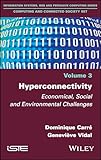Hyperconnectivity : economical, social and environmental challenges / Dominique Carre, Genevieve Vidal.
By: Carre, Dominique [author.]
Contributor(s): Vidal, Genevieve [editor.] | Ohio Library and Information Network
Language: English Series: Information systems, web and pervasive computing series: ; Computing and connected society set: v. 3.Publisher: London : Hoboken, NJ : ISTE Ltd ; John Wiley & Sons, Inc., 2018Description: 1 online resourceContent type: text Media type: computer Carrier type: online resourceISBN: 9781786300874; 9781119557012; 9781119489238; 1119489237Subject(s): Online information services | Communication | Online information services industry -- Economic aspects | Online information services industry -- Environmental aspectsGenre/Form: Electronic books.DDC classification: 004.616 LOC classification: QA76.55Online resources: Full text is available at Wiley Online Library Click here to view| Item type | Current location | Home library | Call number | Status | Date due | Barcode | Item holds |
|---|---|---|---|---|---|---|---|
 EBOOK
EBOOK
|
COLLEGE LIBRARY | COLLEGE LIBRARY | 004.616 C232 2018 (Browse shelf) | Available | CL-52310 |
Includes bibliographical references and index.
Table of Contents
Introduction vii
Chapter 1 The Technological Offer and Globalized Services 1
1.1 Importance of the open communication protocol 2
1.2 Mediation and industrialization of connection 7
1.3 Monopolies and dominance 11
Chapter 2 The Hyperconnected Economy 21
2.1 A free mode of access and use 22
2.2 Two indirect funding methods: advertising and data marketing 28
2.2.1 Advertising revenues 29
2.2.2 Data production and sales 33
2.3 An activation method: solicitation 36
2.4 The government’s involvement 44
Chapter 3 Social Appropriation and Digital Culture 51
3.1 Ambivalence of uses 58
3.2 Industrialization of the uses of interactivity: territories of hyperconnectivity 66
3.3 Uses of interactivity 73
Chapter 4 Renunciation and Negotiations 77
4.1 Uses at the foundation of renunciation and negotiations 77
4.2 Negotiated renunciation 92
Chapter 5 Environmental Issues 105
5.1 Absence of environmental dimension 107
5.2 Materiality of the immaterial 112
5.3 Energy consumption and greenhouse gas production 120
5.4 Impacts of software and website design 127
5.5 Injunctive, ecological and programmed obsolescence 132
5.5.1 Planned obsolescence 133
5.5.2 Injunctive obsolescence 135
5.5.3 Ecological obsolescence 136
Conclusion 139
References 147
Index 161
The use of digital information and communication technologies would be the traces of a social acceptability of the exploitation of all data, in the context of negotiations of uses. This is the reason why the users present themselves actors and contributors of the hyperconnectivity. We would thus witness a new form of dissemination, inviting user experience and social innovations. It is thus the victory of subordination by negotiated renunciation; A new form of serving, no longer that of the 1980s, with the counters and other services, which have become uncontrolled services - excepted when the users are overcome by restrictive ergonomics, revealing too much the subordination device - which joins the prescription apparently without an injunction. The lure is at its height when users and broadcasters come together to produce the services and goods, composing the business model, until the very existence of the companies, in particular the pure players. Crowdsourcing becomes legitimate: consumers create the content, deliver the data, the basis of the service sold (in a painless way because free access most of the time, indirect financing), the providers make available and administer the service, networks , Interfaces (representing considerable costs), also reputation to attract the attention of other consumers or contributors. In these conditions, the environmental stakes are considerable, so we propose another way of considering them, not as they are dealt with - material and pollution - but according to the prism of the relational practices analyzed in this volume.
About the Author
Dominique Carré, Labsic University Paris 13, France.
Geneviève Vidal, Labsic University Paris 13, France.

There are no comments for this item.